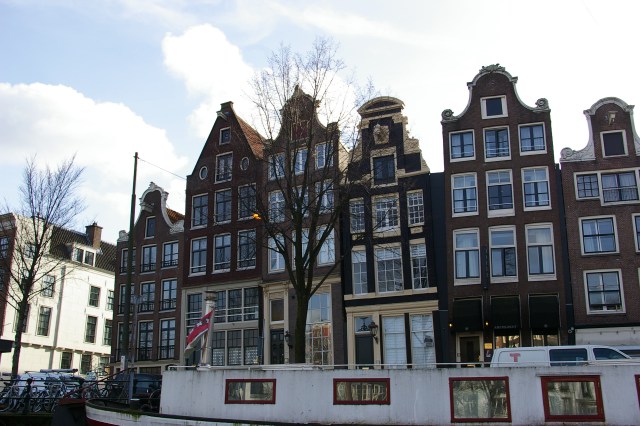Taking walking tours of a city can be a great way to learn interesting facts about a city as well as see important landmarks. The walking tour that we took in Amsterdam was interesting as it was advertised as a free tour where participants are asked to pay the tour guide what they felt was a fair price for the tour that they received. In some ways it forces the tour guide to be more creative, informative, and lively. We are sure that most people pay the same prices as the other paid tours, but you aren’t obligated although we doubt that anyone would truly not pay the guide for the tour.



The tour that we took combined information about the “coffee houses”, the red light district, the history of Amsterdam in World War II, as well as just the general history of the city. We heard many interesting facts and folklore about this city that was built on swampland so many years ago. According to folklore, the first settlers in the area that is now the city of Amsterdam did so as the result of a bet. The first couple of attempts to populate the area failed as the buildings sank into the marsh land. In order to finally build the city, they pounded poles made from trees that are up to 100 feet tall into the moist ground to stabilize the buildings. Eventually they used wind mills to pump the water out and create the canals that crisscross the city.



As for the coffee houses and the history of pot or Marijuana in Amsterdam. We were actually surprised to hear that marijuana is not actually legal in Amsterdam, but they issue permits for the coffee houses to sell marijuana, kind of an odd arrangement. Because it not actually legal, you won’t see any signs specifically saying that they sell marijuana and hence the reason that they are considered and marketed as coffee houses. The story we were told of the first coffee house in the seventies was that the police knew that the owner was selling marijuana, but that heroin use and addicts were a much bigger problem, so they turned a blind-eye to the coffee house and it spread from there. We were also told that Amsterdam took a unique approach to combating heroin as they house the addicts and provide them food, clean lodging, and heroin, which keeps them off of the streets. In fact we did not see anyone begging for food or money on the streets of Amsterdam during our time there. Unfortunately, because it is not legal, but tolerated, the coffee houses have to purchase their marijuana from typical drug cartels, which is not helpful for society in general.



As for the red light district, we just did a quick pass through the streets and wandered passed a couple of the famous windows. It is another unique approach to a controversial topic, but the people of Amsterdam have a live and let live attitude in general, so they are far more tolerant than people in other parts of Europe or the world. The local prostitution union even offers classes for aspiring prostitutes, but the number of windows available for them to use is shrinking as gentrification has started to modify the area. Another interesting fact was that the church in the red light district used to have the sailors pay for their sins before they spent a night of debauchery. Since they wouldn’t have time to go to church prior to having to return to their ships, they would confess what they intended to do with their free time in the red light district, pay for their sins, and then were absolved allowing them to have comfort if they should die during their next voyage.



Other interesting places that we saw were the smallest house in Amsterdam, the Anne Frank House, and learned about the leaning houses that line the canal. Each of the buildings that line the canals have hooks near the roof and the buildings lean slightly forward so that they could use pulleys to raise heavy objects to the upper floors since the stairs are so narrow. If buildings are leaning left or right, that is due to them sinking slightly and it is not intentional. About the only thing that we don’t like about the walking tours is that they almost always bring to a store or two to try some local favorites, like cheese, with the hope that you will buy items from that particular store, most likely producing a kickback to the tour company.



If you get a chance to go to Amsterdam, we would highly recommend taking a walking tour, you will enjoy it. In fact, we would recommend taking walking tours in many cities, even cities in your own local area or the city that you live in. You might be surprised by the things that you learn about a place you thought you already knew.
























